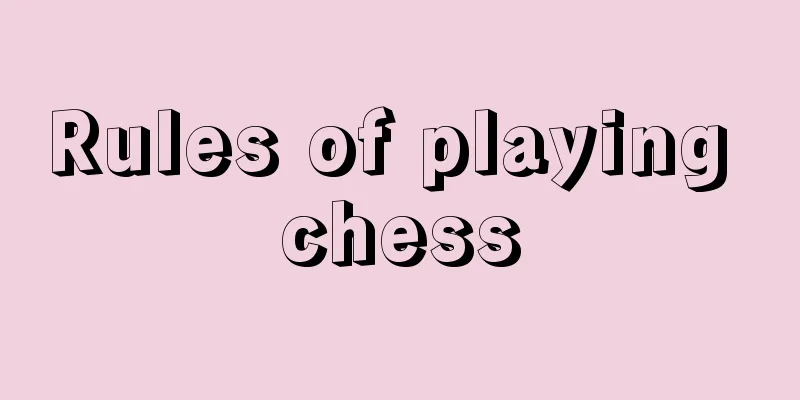Rules of playing chess

|
Many people like to play chess. There are many rules in chess. No matter what kind of game it is, there are rules. If there are no rules, no one will abide by them, and swimming itself will lose its meaning. Many insiders should understand the rules of chess, and we come into contact with a lot of chess in our daily lives, but for those beginners, they don’t know the rules of chess very well. The horse moves in the shape of a sun, and the elephant moves in the shape of a field. These are the rules of playing chess that we usually talk about. We may all know a thing or two about such rules. Many people want to learn how to play chess, but they don't know much about the rules. Today we will introduce to you some rules of playing chess. Detailed rules and winning and losing determination method 1. Know the chessboard and chess pieces: *checkerboard The place where chess pieces move is called a "chessboard". It is a rectangular plane with nine parallel vertical lines and ten parallel horizontal lines intersecting each other, with a total of ninety intersections. The chess pieces are placed on these intersections. The blank area between the fifth and sixth horizontal lines in the middle without vertical lines is called the "river boundary". The entire chessboard is divided into two equal parts by the "river boundary"; the place where the generals of both sides sit and there are "rice"-shaped squares is called the "Nine Palaces". *piece There are 32 chess pieces in total, divided into two groups of red and black, with 16 pieces in each group. Each player holds one group. Each group has the same types of pieces, which are divided into seven categories: Red side: General (1), Minister (2), Prime Minister (2), Chariot (2), Horse (2), Cannon (2), Soldier (5) Black: King (1), Scholar (2), Elephant (2), Rook (2), Horse (2), Cannon (2), Pawn (5) 2. Moves and captures During the game, the player holding the red chess piece moves first, and the two sides take turns making a move until a winner, loser or draw is determined, and the game ends. When it is the turn to make a move, moving a piece from one intersection to another, or capturing the opponent's piece and occupying its intersection, counts as a move. Each side makes one move, which is called a round. How to move various chess pieces: *Shuai (Jiang): Shuai and Jiang are the leaders in chess and are the targets that both sides strive to fight for. It can only move within the "Nine Palaces", up or down, left or right, and each time it moves it can only move one square vertically or horizontally. The king and general cannot be directly opposite each other in the same straight line, otherwise the moving side will be deemed the loser. *Shi(士): Shi(士) is the personal bodyguard of the general, and it can only move within the Nine Palaces. Its chess moving path can only be a diagonal line within the Nine Squares. *Xiang(象): The main function of Xiang(象) is to defend and protect one's own Shuai(将). The way it moves is to move two squares diagonally each time, commonly known as "elephant walking on the field". The movement range of the Xiang (elephant) is limited to its own position within the "river boundary". It cannot cross the river. If there is a chess piece in the center of the "field" it is moving towards, it cannot move, commonly known as "blocking the elephant's eye". * Rook: The Rook is the most powerful piece in chess. It can move in either horizontal or vertical lines, and its number of moves is not limited as long as there are no other pieces blocking it. Therefore, one chariot can control seventeen points, so it is known as "one chariot and ten cold players". *Cannon: When the cannon is not capturing a piece, its movement is exactly the same as that of the rook. *Horse: The horse moves vertically and then diagonally, that is, it moves one square horizontally or vertically first, and then moves diagonally, commonly known as "horse moving day". The horse can choose to go to eight points on the surrounding area at one time, so it is said to be "powerful in eight directions". If there are other chess pieces blocking the direction the horse is going, it will not be able to move forward, commonly known as "the horse's leg is stuck". * Soldier (pawn): Before crossing the river, the soldier (pawn) can only move forward step by step. After crossing the river, except that he cannot move backward, he is allowed to move left and right, but only one step at a time. 3. Capture When any chess piece moves, if there is an opponent's chess piece at the target position, you can take the opponent's chess piece out of the chessboard and replace it with your own chess piece (i.e. "capture"). Only the cannon's way of capturing pieces is different from that of other pieces: there must be a piece between the cannon and the piece to be captured, so the cannon can capture the piece by jumping, commonly known as "setting up the cannon" or "cannon hitting the piece in between". 4. General, General to be, General to be killed, General to be trapped A chess piece of one side attacks the other side's general (king) and attempts to capture it in the next move, which is called "checkmate" or simply "general". The party that is in check must respond immediately, that is, use self-defense moves to resolve the check situation. If you are in check and cannot counter, you are considered to be in check. When it is the player's turn to make a move, although the general is not "encircled" by the opponent, he is trapped in a position with no way to move. At the same time, the other chess pieces on the player's side cannot move either, and he is said to be "trapped". 5. Win, Lose, Draw During a game, if one of the following situations occurs, the player loses the game and the other player wins: * The general is "checkmated" by the opponent, that is, the opponent's general is unable to counter the general; * Being "trapped", that is, although the opponent has not checked the opponent, the player has no more moves to make; *Declare defeat on your own. *If one side has a longer general, it will remain unchanged; otherwise, the side with a longer general will be considered the loser. The game is considered a tie if: * When one party takes a turn, he proposes a draw and the other party agrees; *When both sides' long pieces remain unchanged, which complies with the rule of "draw if unchanged" in the "Chess Rules", and both sides are unwilling to change their moves. 6. Terminology (1) Check: When one side's chess piece captures the other side's general in the next move, it is called "check". (ii) Checkmate: The counterattack, evasion or defensive moves taken by the player who is in checkmate. The methods that should be used are: Capture the opponent's "checkmate" piece. The general avoids the position from which he is attacked. Placing your own chess piece between the opponent's "general" chess piece and your own general is commonly known as "pad the general". When you encounter the opponent's cannon "check", in addition to the above "response" method, you can also withdraw the chess piece that is used as a cannon mount. If you encounter a horse in "check", you can also use your own chess pieces to clamp the horse's legs. (III) Checkmate: If a player is in check and cannot counter-attack, he is considered checkmate. (iv) Trapped: When it is the turn of the player to make a move, the general is not "checked" but is confined to a position with no way to move. At the same time, the other chess pieces on the side cannot move either. This is considered "trapped". (V) River boundary: two horizontal lines forming the river boundary. (6) Patrolling the River: When one side's chess piece is on its own "river boundary", it is called "patrolling the river". (VII) Riding the River: When one side's chess piece is on the other side's "river boundary", it is called "Riding the River". (8) Center line: The fifth vertical line on the chessboard, usually represented by "five" (red side) or "5" (black side). (IX) Rib Line: The 4th and 6th vertical lines on the chessboard, usually represented by "four" and "six" (for red) or "4" and "6" (for black). (10) Pawn Line: The first horizontal line below the "River Line" on the chessboard. Pawns and soldiers are placed on this line. (11) Palace top line: The horizontal line below the soldier line (pawn line), which is named because it is the top line of the "Nine Palaces". (12) Bottom line: the first horizontal line at both ends of the chessboard. (13) Game: The game between two parties is called a "game", and the game of chess is called a "game of chess". (14) Overall: refers to the entire process of the game. It includes three stages: "opening", "middle game" and "endgame". (15) Situation: refers to the distribution of chess pieces of both sides at a certain stage in the game. It usually includes "first move", "second move", "advantage", "stable", "confrontation", "complexity", "balance" and so on. (16) The first move at the beginning of the game. (17) Winning momentum: In the game, the situation is generally determined. The party that is on the verge of victory is called the "winning party". (XVIII) Victory is certain: In a game, one side has more pieces and an advantage, while the other side has fewer pieces and has no means to fight back or change, resulting in a situation where defeat is inevitable. The side with more pieces and an advantage calls the game a "winner". (19) A decisive move: In a game, when one player is about to kill the other player with the next move, and the other player is unable to rescue him, it is called a "definitive move". The rules of chess are very simple, although there are so many of them. If you understand them thoroughly, you can make good use of them. Every game has rules. Some people may feel that the rules of the game are complicated and annoying, but some people will study the rules of the game thoroughly and make good use of them to win. |
Recommend
Signs of colon cancer in stool
Why is normal bowel movement an important indicat...
What to do with ovarian cancer
Ovarian cancer is a malignant tumor that is not e...
The method to completely cure rheumatism
Once you get rheumatism, it will continue to torm...
What are the effects of dried sesame leaves
Everyone is familiar with sesame, which is used a...
Which groups of people need to be screened for pancreatic cancer
In recent years, the number of deaths from pancre...
Self-treatment of mental illness? How to treat mental illness
Some people suffer from mental illness without kn...
How many levels and types are there of breast cancer
Breast cancer may be caused by genetics, early me...
What harm does mosquito coils do to pregnant women?
Mosquito-repellent coils are used in our daily li...
What are the treatments for knee pain
Nowadays many of us are exhausted from work. So a...
What are the symptoms of patients with advanced gastric cancer?
What are the symptoms of patients with advanced g...
How to clean dried clams?
For easy storage, many people dry fresh razor cla...
Color fades after washing hair
Anyone who has dyed their hair knows that the col...
Do you know what are the early symptoms of laryngeal cancer?
Depending on the type of laryngeal cancer, the on...
What to do if your spine is deformed?
The spine is one of the most complex skeletal tis...
Remember: Dietary principles for bone tumors
Patients with bone tumors should not only take go...









